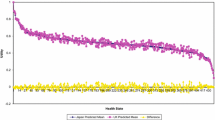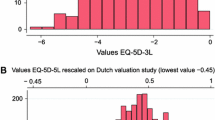Abstract
The EQ-5D questionnaire is a widely used generic instrument for describing and valuing health that was developed by the EuroQol Group. A primary objective of the EuroQol Group is the investigation of values for health states in the general population in different countries. As part of the EuroQol enterprise 11 population surveys were carried out in six Western European countries (Finland, Germany, The Netherlands, Spain, Sweden and the UK) to value health states as defined by the EQ-5D using a standardised visual analogue scale (EQ-5D VAS). This contribution reports how a European set of general population preference weights was derived from the data collected in the 11 valuation studies. The scores from this set of preference weights can be applied to generate a VAS-based weighted health status index for all the potential 243 EQ-5D health states for use in multi-national studies. To estimate the preference weights a multi-level regression analysis was performed on 82,910 valuations of 44 EQ-5D health states elicited from 6,870 respondents. Stable and plausible solutions were found for the model parameters. The R 2 value was 75%. The analysis showed that the major source of variance, apart from 'random error', was variance between individuals (28.3% of the total residual variance). These results suggest that VAS values for EQ-5D health states in six Western European countries can be described by a common model.

Similar content being viewed by others
References
Brooks R (1996) EuroQol: the current state of play. Health Policy 37:53–72
EuroQol Group (1990) EuroQol-a new facility for the measurement of health-related quality of life. Health Policy 16:199–208
Johnson J, Ohinmaa A, et al (2000) Comparison of Finnish and US-based visual analog scale valuations of the EQ-5D measure. Med Decis Making 20:281–289
Agt HM von, Essink-Bot ML, Krabbe PF, Bonsel GJ (1994) Test-retest reliability of health state valuations collected with the EuroQol questionnaire. Soc Sci Med 39:1537–1544
Essink-Bot ML, Stouthard MEA, Bonsel GJ (1993) Generalizability of valuations on health states collected with the EuroQol-questionnaire. Health Econ 12:237–346
Gudex C (1992) Are we lacking a dimension of energy in the EuroQol instrument? In: Björk S (ed) EuroQol conference proceedings. Lund, October 1991. Lund: IHE, pp 61–82
Gudex C, Dolan P, Kind P, Williams A (1996) Health state valuations from the general public using the visual analogue scale. Qual Life Res 6:521–531
Williams A (1995) The measurement and valuation of health: a chronicle. Discussion paper no 136. York: Centre for Health Economics
Gudex C, Dolan P, Kind P, Thomas R, Williams AH (1997) Valuing health states. Interviews with the general public. Eur J Public Health 7:441–448
Ohinmaa A, Eija H, Sintonen H (1996) Modelling EuroQol values of Finnish adult population. In: Badia X, Herdman M, Segura A (eds) EuroQol 1995 Barcelona Plenary Meeting, 3–6 October. Barcelona: Institut de Salut Pública de Catalunya, pp 67–76
Badia X, Fernández E, Segura A (1995) Influence of sociodemographic and health status variables on valuation of health states in a Spanish population. Eur J Public Health 5:87–93
Gaminde I, Cabasés J (1996) Measuring valuations for health states amongst the general population in Navarra (Spain). In: Badia X, Herdman M, Segura A (eds) EuroQol 1995 Barcelona Plenary Meeting, 3–6 October. Barcelona: Institut de Salut Pública de Catalunya, pp 113–122
Badia X, Roset M, Herdman M, Kind P (2001) A comparison of United Kingdom and Spanish general population time trade-off values for EQ-5D health states. Med Decis Making 21:7–16
Björk S, Norinder A (1999) The weighting exercise for the Swedish version of the EuroQol. Health Econ 8:117–126
Schulenburg J. Graf von der, Claes C, Greiner W, Uber A (1998) Die deutsche Version des EuroQol-Fragebogens. Z Gesundheitswiss 6:3–30
Claes C, Greiner W, Uber A, von der Schulenburg JM Graf (1998) The new German version of the EuroQol quality of life questionnaire. In: Rabin RE, Busschbach JJV, de Charro FT, Essink-Bot ML, Bonsel GJ (eds) EuroQol Plenary Meeting, Rotterdam 1997, 2–3 October. Rotterdam: Centre for Health Policy and Law, Erasmus University, pp 93–114
Claes C, Greiner W, Uber A, von der Schulenberg J-M Graf (1998) An interview-bases comparison of the TTO and VAS values given to EuroQol states of health by the general German population. In: Greiner W, von der Schulenburg JM Graf, Piercy J (eds) EuroQol Plenary Meeting, Hanover 1998, 1–2 October. Hanover: Uni-Verlag Witte, pp 13–38
Ohinmaa A, Sintonen H (1999) Inconsistencies and modelling of the Finnish EuroQol (EQ-5D) preference values. In: Greiner W, von der Schulenburg JM Graf, Piercy J (eds) EuroQol plenary meeting, Hanover 1998, 1–2 October. Hanover: Uni-Verlag Witte, pp 57–74
Kreft I, de Leeuw J (1998) Introducing multilevel modeling. London: SAGE
Dolan P (1997) Modeling valuations for EuroQol health states. Med Care 35:1095–1108
Busschbach JJV, McDonell J, Essink-Bot M-L, van Hout BA (1999) Estimating parametric relationships between health description and health valuation with an application to the EuroQol EQ-5D. J Health Econ 18:551–571
Macran S, Kind P (2001) "Death " and the valuation of health-related quality of life. Med Care 39:217–227
Acknowledgements
This research, performed on data collected previously, was supported by a grant from the European Community: Biomed II programme PL 963118, Concerted Action. The authors acknowledge the contributions of the participants of the Biomed EQ-net project, whose effort and expertise made it possible to produce this paper. We particularly thank Stefan Björk (Novo Nordisk A/S, Bagsvaerd, Denmark), Marie-Louise Essink-Bot (Department of Public Health, Erasmus University Rotterdam, The Netherlands) and Idoia Gaminde (Departamento de Salud, Gobierno de Navarra, Pamplona, Spain) for providing data. We also thank Rosalind Rabin who edited the English. Earlier versions of this manuscript were presented at the Biomed EQ-net scientific meetings.
Author information
Authors and Affiliations
Corresponding author
Appendix
Appendix
Tables 5 and 6 present, respectively, the number of valuations per sample and the mean, median and estimated values, with the differences between mean or median and estimates
Rights and permissions
About this article
Cite this article
Greiner, W., Weijnen, T., Nieuwenhuizen, M. et al. A single European currency for EQ-5D health states. HEPAC 4, 222–231 (2003). https://doi.org/10.1007/s10198-003-0182-5
Issue Date:
DOI: https://doi.org/10.1007/s10198-003-0182-5




